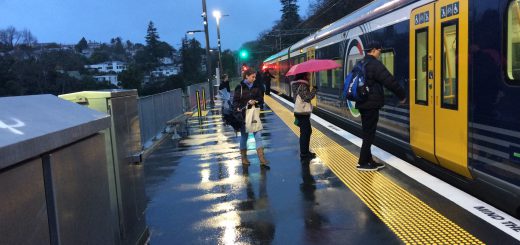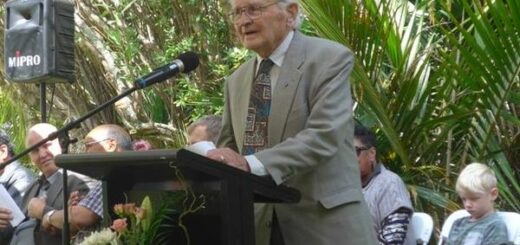The planned sell-out of Ports of Auckland – and why selling is losing
The Spinoff series. Storm in a Port series
One would have hoped given all the problems Mayor Phil Goff has right now, the unhappy progress of his ‘bed tax’ for example and his council’s own systemic problems, with only 18% of Aucklanders trusting it, that he would have clearly and forcefully dispelled rumours about plans to privatise the Ports of Auckland. The port company is Auckland’s premier strategic asset – owned by the people of Auckland it was built and handed down to us by earlier generations of Aucklanders. It pays the council a dividend of $40-$50m per annum
Unfortunately Phil Goff’s equivocating ‘denials’ of what was discussed at a secret meeting last week with the port company chair and CEO (and leaked to the media by one of the parties) have only served to fuel the rumours. And Goff’s repeated comments about wanting to move the port have only added another element of confusion.
I recall the last time a serious attempt was made to sell the Ports of Auckland, This was back in 1991- at the height of the ‘reforms’. The Auckland Regional Council which held 80% of shares (the Waikato Regional Council held the other 20%), was under instructions from the National government to privatise the company. Finance sector players like Fay Richwhite and Bancorp were deeply and lucratively involved. The suggested sale price (by these experts) was $200m which happily coincided with the ARC debt. Then came an enormous public outcry. At the height of it I was elected in a by-election to the ARC. Within two weeks, in March 1992, the late Bruce Jesson and myself proposed a notice of motion to stop the sale. After long and rather dramatic debate it was carried by 13 votes to 12. A year later the Waikato Regional Council did sell its 20% of shares. Immediately upon listing, to its dismay and no doubt eternal regret, the share price virtually doubled. This meant that from 1993 to 2005 Ports of Auckland was a stock-exchange listed company. However despite the magical properties, that star dust that some believe stock exchange listing brings, the company was for all those years outperformed and outsmarted by its provincial rival the Port of Tauranga which in a major strategic coup acquired the inland port at Penrose, under the very noises of the Auckland company.
In 2005 soon after I became chairman of the ARC, we bought back the 20% listed shares and took 100% control of the company. The reason was two-fold. The Port was a sound blue-chip investment in itself, but it also meant we were able to divest the valuable Wynyard Quarter and ‘tank farm’ land out of the control of port executives (whose development plans for the area were frankly hopeless), and get the company to focus on its core business – shifting cargo more efficiently.
Since the demise of the ARC and the advent of the Super City, there has been much less public oversight and transparency around the port company. In the leadership vacuum, it appeared to me that the directors began to act as if they were the owners. They soon came to grief in the employment court over a clumsily managed, bitter and very costly labour dispute in 2012 and then three years later the high court over the company’s pig-headed drive to reclaim the Waitemata Harbour. Still, since the decision to abort the sale in 1992, the port company has gone on to pay the Auckland region more than $1b in dividends, as well as bequeathing an extremely valuable real estate portfolio. That dividend stream enabled the development of the Britomart transport centre, the North Shore busway and in particular the infrastructure for the renaissance of Auckland commuter rail.
But now for a number of reasons, it seems privatisation is back on the table and the circus is back in town. And predictably enough out front leading the parade, and banging a noisy drum is Michael Barnett of the Auckland Chamber of Commerce.
It is not unexpected that the head of a business lobby group would take such a position – it’s his ‘brand’ as Michael would explain. However lobbying on behalf of the finance sector, so it can take a big clip out of the ticket of any privatisation to new owners, likely offshore based, is not going to win the hearts and minds of Aucklanders. So by necessity privatisation arguments must be dressed up as if to be in the public interest. It is this sales spin delivered in public good clichés, featuring ‘Ma and Pa Aucklanders’, and even ‘liberating’ the port (??), must be exposed for what it is.
However Michael Barnett is not the mayor of Auckland, Phil Goff is and he is the primary problem here.
Goff’s approach to the port is much less coherent than Barnett’s. Goff despite his obfuscating is clearly interested in selling the port, however he has also made it clear he wants to move the port. It appears he still doesn’t realise that if you sell a port, it’s not like selling a car. A sold port will not be taken off to a new home. In fact wanting to move the port is logically incompatible with wanting to sell the port. Such public opining by the mayor of Auckland, constantly raising doubts about the port’s long-term security of tenure serves to strip millions of dollars of potential value out of the company. Given this muddleheadedness, if Ernst & Young, Cameron & Partners, the Chamber of Commerce and council senior management get their way and the port is sold you can be sure the international buyer is likely to get it at a knock-down price. However there should be no illusions, once gaining control no new owner is going to take seriously requests to take its newly-acquired port off somewhere else.
Goff also says he wants to keep the land but sell the company. Separating out the land and selling off the revenue-earning operating business is a dodge long used by those scheming to get their hands on the port. When I was chairman of the Auckland Regional Council I had to deal on a regular basis with hard-faced finance people (including the Sultan of Dubai) proposing variations on this scheme; to hear them out and show them the door.
Goff surely by now must be aware that the only significant ‘land’ remaining on Ports of Auckland’s books is the reclaimed rubble locked beneath the tarmac of the container terminals. Everything above that is core port operations. Nearly all the worthwhile real estate has already been sold or taken out of Ports of Auckland, including the downtown Britomart precinct land, the Viaduct and associated land, Westhaven Marina and the Wynyard Quarter, Wynyard Point land.
Interestingly Michael Barnett’s sales pitch is couched in terms of financial prudence, enabling Auckland to spend the proceedings on much needed infrastructure etc. This is not without irony given it was Michael’s lobbying on behalf of the trucking that helped land Auckland with the $1.8b ‘East West Link’, considered to be the most expensive road in New Zealand’s history – so lacking in demonstrable benefits, that NZTA is unable to contrive a meaningful cost-benefit analysis. (Very interestingly the main beneficiary is the Port of Tauranga’s inland port).
Essentially Barnett’s argument (based on he reckons ‘real commercial sense’) can be boiled down to this: let’s sell Auckland’s principal strategic revenue-earning asset to pay for other, non-revenue earning assets. However these assets, (including the roads Barnett is championing), and City Rail Link will have high and on going operational costs. Once the proceeds from selling the port, after the brokers, the finance consultants and lawyers have had their chop, is spent, and the port company’s $40-$50m per year dividend steam is diverted to the new shareholders, (the annual shortfall would have to be made up with a 3% rates increase), who is going to be left to pay these operational costs? You guessed it, the ratepayers. That is why Barnett’s slippery sales patter and Goff’s commercial naivete, and lack of political principle should be seen for what they are.
What should be done about the port? Apart from its sometimes, roguish attitude, by and large it is performing efficiently. Return on operating capital is similar to Tauranga. The major problem with Ports of Auckland (interestingly completely opposite to Auckland Council) is not cost control but constraints on its ability to earn revenue. This is due to the mutually damaging, race-to-the-bottom competition between Auckland and Tauranga over containers. This means what the ports can charge for containers is about 40% lower than what Australian ports charge. Auckland’s business strategy is almost entirely based on containers, Tauranga’s main game is bulk exports. Tauranga can bleed Auckland but still do OK itself. But if Auckland (and Tauranga) were to be able to charge something near the international going rate for handling containers, Ports of Auckland profits and dividends would be increased significantly, for example a mere $10 increase per container would mean $10m extra on the bottom line, $20 – $20m. There has been some improvement to this in recent years but there is still a huge commercial distortion which real leadership at Auckland and central government would set out to resolve – and there is a solution – a jointly-owned container operating company.
The benefits for the company (both companies) and the people of Auckland (and the people of the Bay of Plenty) would be significant. On the other hand selling the port is selling out Auckland’s future generations. Selling is losing.
See also: https://thespinoff.co.



